How to Write a Day Spa Business Plan: Complete Guide
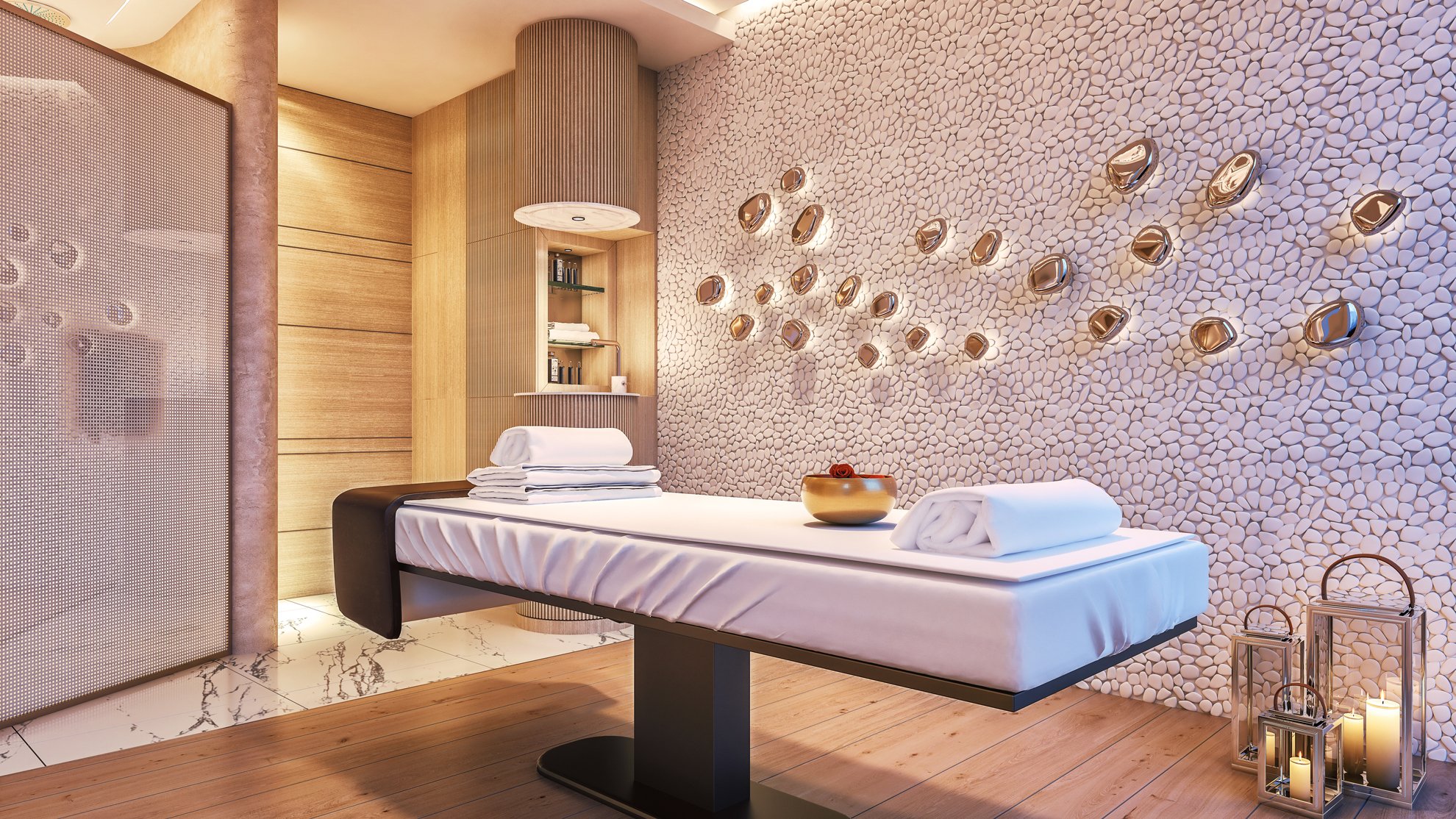
Whether you’re looking to raise funding from private investors or to get a loan from a bank for your day spa, you will need to prepare a solid business plan.
In this article we go through, step-by-step, all the different sections you need in your day spa business plan. Use this template to create a complete, clear and solid business plan that get you funded. Let’s dive in!
For more information on day spas and other wellness centers, make sure to read our guides below: How To Open a Day Spa In 10 Steps? How Much Does It Cost to Open a Day SPA? Examples How To Build a Financial Model For a Day Spa?
1. Executive Summary
This is the first part and the most important section of your business plan. This is the first thing lenders and/or investors will have a look at.
Before we dive into the specifics, keep in mind the executive summary is a summary: keep it to 2 pages maximum.
Your executive summary should briefly sum up the key sections of your business plan as well as presenting the funding ask.
Why businesses prepare business plans?
The funding ask (or funding requirement), as explained below, is the reason why any business would have a business plan. Business plans are prepared for one of the 3 following objectives:
- Obtain financing from a bank or any other lender (a SBA loan for example)
- Obtain financing from private investors (business angels, investment funds, etc.)
- Get approval for a private or public grant
How to write an executive summary for a day spa business plan?
Day spas should include the following information in their executive summary:
- Business overview: the name of your company, its legal structure, the business model (franchise vs. independent day spa) and the type of treatments you will offer (massage parlor, sauna & wellness day spa, manicure & pedicure beauty spa, etc.)
- Market analysis: how big is the spa and wellness industry in your area? How many day spas are there? How many customers do they have per day, per week? How much are your competitors quoting on average for their treatments?
- People: who is the management team? what is your/their experience in the spa industry?
- Financial plan: what is your expected revenue and profitability for the next 5 years? When do you expect to break-even? Simply include here a chart of your key financials (e.g. Revenue, Gross Profit, Net profit)
- Funding ask: what loan/investment/grant are you seeking? How much do you need? How long will this last?
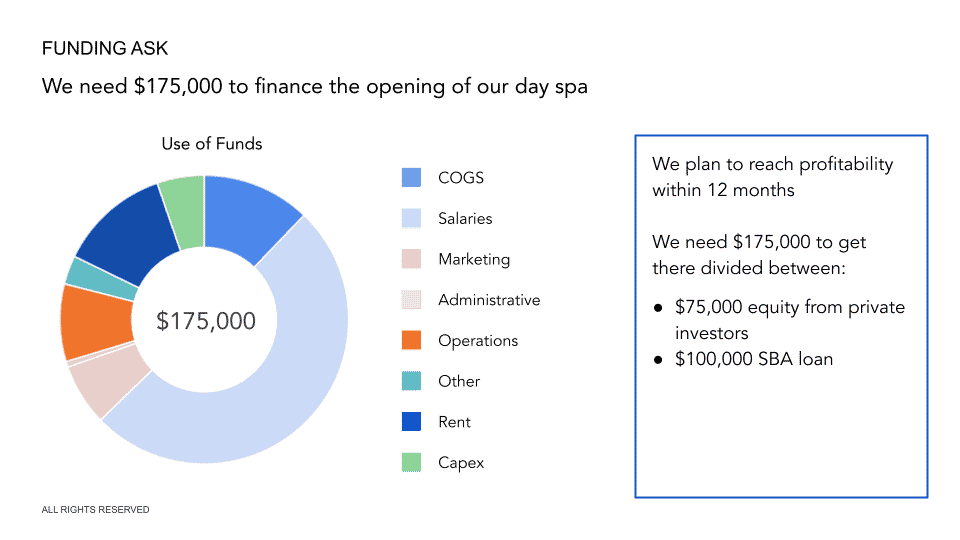
2. Business Overview
The business overview (or “Company description”) is the 2nd section of your business plan. It should cover all the important aspects of your day spa: what treatments and other services you sell, how are the treatments priced, who are your customers, how the company is structured, etc.
Let’s now see one by one the different pieces of information you should cover here:
History
As an introduction, briefly explain the genesis of the project: when, how and why you decided to start your own day spa. What gave you the idea to start a new spa today?
Anything that shows investors or lenders passion and most importantly the background and rationale of you deciding to open a new spa today goes a long way.
For example, you might be a massage therapist who realised there was a gap in your neighborhood between the potential customers who enjoy getting a massage regularly and the existing massage offering.
Are existing competitors always overbooked? Are existing day spas only offering beauty treatments but no massages? Those may be signs that there is a real need to open a new massage parlor in your area.
Business Model
You should explain here whether:
- You plan to open a new independent day spa ; or
- Whether you are buying an existing spa which you intend to take over ; or
- You are franchising with an existing well-known day spa brand.

Treatments and services
An important part of any day spa business overview is to explain to your readers (investors or lenders) what type of day spa you intend to open. In other words, what are your day spa treatments you will offer.
Indeed, there are a variety of day spas and it’s always better to specialise.
For example, you may open a day spa that solely focuses on massages, facial and body scrub treatments. Instead, you could focus on relaxation but avoid beauty treatments, such as a sauna and steam room day spa with massages.
You could even specialize in a mineral springs spa where you offer hydrotherapy treatments. Another good example of a specialized spa are airport spas that offers short massage & treatments to busy professionals and travellers.
Pricing strategy
A great addition to this section is to include your price list. This will give investors and lenders a very clear view on your establishment’s offering and pricing strategy, which they will later tie into your financial projections (see more on that below).
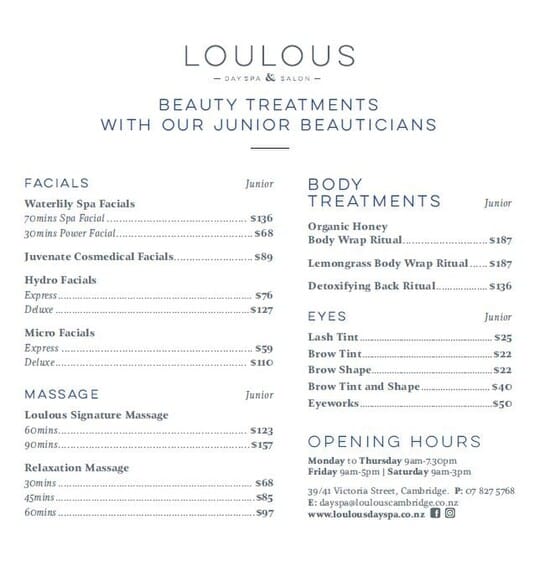
Target Audience
Another important part of the business overview section of your day spa business plan is your target audience.
Who is your typical customer? What is their age range? What percentage of your target customers are female vs. male? Why do they go to a day spa: for relaxation (e.g. massages) or beauty treatments)?
For example, it may be better to open a massage parlor offering short (30min and 45min) massages in a busy city center rather than a sauna & steam room offering a $175 flat rate offer for 3h access to a sauna in addition to a 1h massage.
Knowing exactly who are your target customers will give you an edge over competition to attract and retain them.

Legal Structure
Finally, your business overview section should specify what type of business structure you opt for. Is this a corporation or a partnership (LLC)? Who are the investors? How much equity percentage do they own? Is there a Board of Directors? If so, whom? Do they have experience in the industry?
3. Market Analysis
The market analysis is an important section of your day spa business plan. Here, you should show lenders and/or investors that you understand the day spa industry and its current trends.
More importantly, it should prove to anyone that opening your day spa in your area today makes total sense based on market and competition dynamics.
For example, it’s always best to open a day spa in an area where competition is limited (as long as there is sufficient demand). Also, you wouldn’t open a high-end spa charging day rates including massages and beauty treatments in an low middle class neighborhood.
Market trends
The first part of your market analysis should answer the following 2 questions:
- What is your market size? In other words, how big is the day spa industry in your area?
- How fast is your market growing today?
First, you will need to define what is your market. Is this the day spa industry in the US? Or are you referring specifically to the massage spa industry in Austin?
Keep in mind that it’s always better to be more specific. For example, it’s better to define your market at a city level where you plan to open your gym (Austin here for example) vs. for the US as a whole.
Don’t get us wrong, it’s always good to add national figures as an introduction. For example, PwC estimated in 2018 that the average annual revenue for a day spa was $803,000. Given there were over 21,000 day spas in the US in 2020, we can estimate the US day spa market at around $17 billion per year.
You can do the same math for your area. For example, how big is the day spa industry in your area? Assuming it’s Austin, then how big is your market?
When it comes to growth, pay attention to the number of day spas in your area. For example, assuming there were 200 day spas in Austin in 2021 and 220 in 2022, we can assume your market is growing by 10% each year.
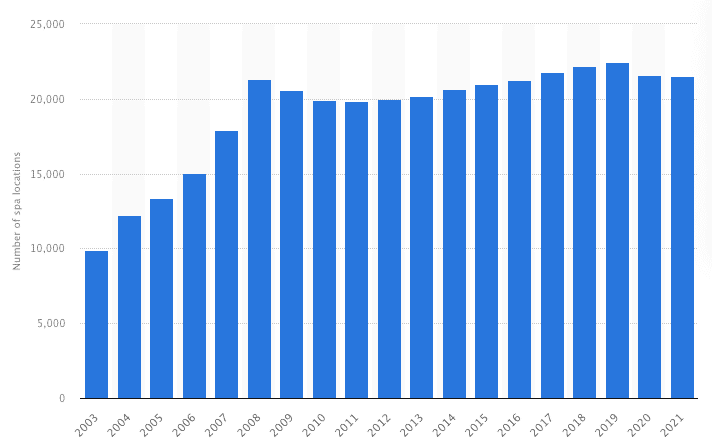
Competition
The 2nd step of your market analysis is to describe competition in your area. There are a few questions to answer here:
- How many day spas are there in the area?
- What types of spas are they (massage spas, medical spas, beauty treatment day spas, etc.)?
- What type of treatments do they offer?
- What is the price point of your competitors (how much do they charge on average per treatment)?
- How many staff do they employ?
- How many customers do they have (approximately)?
Why you need a competitive analysis in your day spa business plan
The conclusion to your competitive analysis should be that there is a strong rationale for opening a day spa in your area today. For example it can be that:
- There is no existing high-end day spa offering beauty treatments, a pool, sauna and steam rooms despite being an affluent area
- Existing massage parlors only offer thai massages. There is no day spa offering other types of massages e.g. aromatherapy, hot stone or even deep tissue massages. There could be a great opportunity to offer some beauty treatments as well (facials for example)

Customers
We already touched upon your target audience in the Business overview section earlier.
Here instead, the objective is to show lenders and investors that your target audience actually exists and live in the area where you plan to open a new day spa.
As such, you should explain here who are the customers who go to other day spas in your area. Especially, you should be able to answer the following questions:
- What is the age range of day spa customers in your area?
- What percentage of your target customers are female vs. male?
- What’s their average disposable income? Are they more middle class or affluent?
- What are existing day spa customers in your area interested in? Are they looking for a weekly 45min massage or instead a unique experience where they would go once or twice a year for an entire day (like a day package)?
- Are existing customers more looking for relaxation or beauty treatments? If the latter, is the demand already filled by beauty salons in the area, or would it make sense to include beauty treatments as part of your day spa?
When you present customers here, you should always tie it into competition. Are day spa customers in your area finding what they want, or is there a gap to fill in the market instead?
Studying competition is also very important to find information about potential customers. For example, it wouldn’t make any sense for you to open another massage parlor in an area where your only competitor is already struggling to pay rent.
4. Sales & Marketing Strategy
Your day spa business plan should include a sales & marketing plan where you outline your strategy to acquire your target customers.
For example, you should answer the following questions:
- What channel(s) do you plan to use (online vs. offline marketing channels)?
- How does it make sense for your target audience? For example, social media may be your best bet to attract young adults to your new day spa. Instead, billboards may be too expensive in certain areas
- What is your unique selling proposition?
- What is your expected marketing budget?
- How will you track whether your marketing strategy is profitable? What’s your customer acquisition cost (CAC)?
- What strategies and promotional offers do you plan on using in the early days to attract your first customers?
Let’s expand a bit on a few questions below:
What marketing channels do day spas use?
A few marketing channels day spas typically use are:
- Email marketing
- Social media
- Pay-per-click campaigns (e.g. Google Ads)
- Sponsorships (especially for B2B customers)
- Partnerships (for example with gyms and fitness clubs, companies, etc.)
- Billboards
- Radio
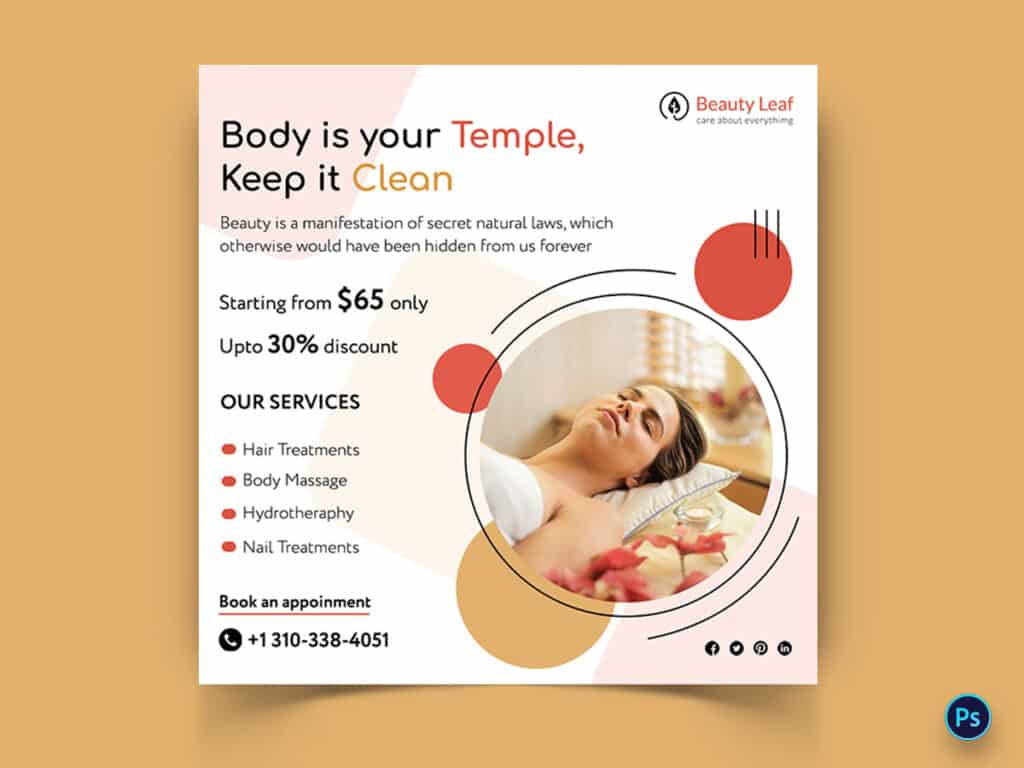
What is your unique selling proposition?
In other words, how do you differentiate yourself vs. competitors? This is very important as you might need to win customers from competitors.
A few examples of USPs are:
- Price: you may be cheaper vs. your competitors
- Location: your day spa might be closer to your target customers or in a busier street for example
- Quality: you offer higher-quality treatments (better trained therapists and aestheticians), state-of-the-art equipments (e.g. steam rooms, sauna), an overall better design and layout, etc.
- Pure player: you aim to be the go-to spa for high-end day packages (e.g. honey moon, anniversary gifts, etc.)
5. Management & Organizational Structure
The 5th section of your day spa business plan should be about people. It should include 2 main elements:
- The management team and their experience / track record
- The organizational structure: what are the different teams and who reports to whom?
Management
Here you should list all the management roles in your company. Of course, the amount of details you need to include here varies depending on the size of your company. A franchise business with a number of day spas would need more detail vs. an independent spa.
If you plan on running your business independently, you may write a short paragraph explaining who are the co-founders and/or senior managers (if there are any in addition to yourself). It’s important to highlight their experience in the industry and previous relevant professional experiences.

Organizational structure for a day spa
No matter how many leadership roles there are, you should now explain how you intend to run the company from a management standpoint.
What are the different teams (management, therapists, receptionists, etc.)? Are they any key supervisory roles who aren’t part of the management team (e.g. team leaders). Note that you should include these details even if you haven’t hired anyone yet. It will show lenders and investors that you have a solid hiring and management plan to run the business successfully.
A great addition here is to add an organizational chart that list all the roles, from Directors to managers, key supervisory roles, employees and contractors. Make sure to highlight with reporting lines who manages/supervises whom.
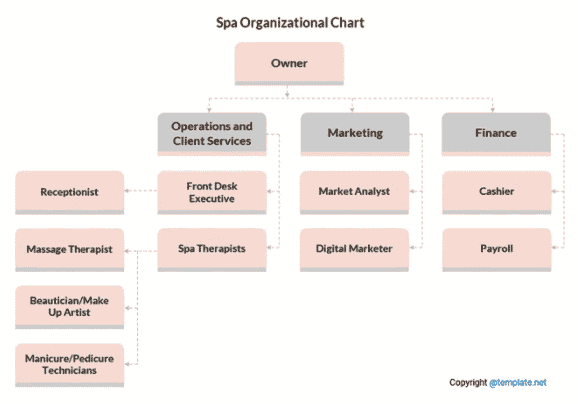
6. Financial Plan
The financial plan is perhaps, with the executive summary, the most important section of any business plan.
Indeed, a solid financial plan tells lenders that your business is viable and can repay the loan you need from them. If you’re looking to raise equity from private investors, a solid financial plan will prove them your day spa is an attractive investment.
Remember: business plan are meant to obtain funding (a loan, grant or equity) from investors or a bank. These lenders or investors are people with strong financial analysis skills. Therefore, they will mostly look at your project from a financial standpoint. You might have the best day spa out there, yet if your business isn't profitable no one will invest, let alone lend you money.
There should be 3 sections to your financial plan section:
- Your historical financials (only if you already operate the business and have financial accounts to show)
- The startup costs of your project (if you plan to open a new day spa, purchase new equipment, renovate your facilities, etc.)
- The 5-year financial projections
Historical Financials (if any)
In the scenario where you already have some historical financials (a few quarters or a few years), include them. A summary of your financial statements in the form of charts e.g. revenue, gross profit and net profit is enough, save the rest for the appendix.
If you don’t have any, don’t worry, most new businesses don’t have any historical financials and that’s ok. If so, jump to Startup Costs instead.
Startup Costs
Before we expand on 5-year financial projections in the following section, it’s always best practice to start with listing the startup costs of your project. For a day spa, startup costs are all the expenses you incur before you can open your spa and make money.
These expenses mostly include:
- The lease deposit for the space you rent
- The design and renovation of the existing facilities
- The equipment and furniture
It costs on average $203,000 – $328,000 to open a new day spa.
The startup costs depend on a number of factors, for example the size of your spa (how many treatment rooms you have), the quality of the design, interior and equipment, and the treatments you offer. Whilst a casual massage spa without any beauty machines can keep costs down to $10,000, a premium day spa with 4 – 5 sets of high quality machines (e.g. facial machinery, steamers, etc.) can spend more than $50,000 easily.
For a full review of how much it costs to open and run a day spa, have a look at our complete guide here.
| Startup cost | Amount |
|---|---|
| Lease deposit | $10,000 – $20,000 |
| Design & renovation | $180,000 – $260,000 |
| Equipment & furniture | $10,000 – $40,000 |
| Licenses & certifications | $1,000 – $5,000 |
| Insurance | $2,000 – $3,000 |
| Total | $203,000 – $328,000 |
Financial Projections
In addition to startup costs, you will now need to build a solid financial model over 5 years.
Your financial projections should be built using a spreadsheet (e.g. Excel or Google Sheets) and presented in the form of tables and charts in the business plan of your day spa.
As usual, keep it concise here and save details (for example detailed financial statements, financial metrics, key assumptions used for the projections) for the appendix instead.
Your financial projections should answer at least the following questions:
- How much revenue do you expect to generate over the next 5 years?
- When do you expect to break even?
- How much cash will you burn until you get there?
- What’s the impact of a change in pricing (say 20%) on your margins?
- What is your average customer acquisition cost?
You should include here your 3 financial statements (income statement, balance sheet and cash flow statement). This means you must forecast:
- The number of customers over time ;
- Your expected revenue ;
- Operating costs to run the business ;
- Any other cash flow items (e.g. capex, debt repayment, etc.).
When projecting your revenue, make sure to sensitize pricing and the number of members / customers as a small change in these assumptions will have a big impact on your revenues.
When it comes to the costs, consider both startup and operating costs. For more information, read our article on how much it costs to open a day spa.

7. Funding Ask
This is the last section of your day spa business plan. Now that we have explained what your day spa business model is about, what’s your strategy, where you go and how you get there, this section must answer the following questions:
- How much funding do you need?
- What financial instrument(s) do you need: is this equity or debt, or even a free-money public grant?
- How long will this funding last?
- Where else does the money come from? If you apply for a SBA loan for example, where does the other part of the investment come from (your own capital, private investors?)
If you raise debt:
- What percentage of the total funding the loan represents?
- What is the corresponding Debt Service Coverage Ratio?
If you raise equity
- What percentage ownership are you selling as part of this funding round?
- What is the corresponding valuation of your business?
Use of Funds
Any day spa business plan should include a clear use of funds section. This is where you explain how the money will be spent.
Will you spend most of the loan / investment in paying your employees’ salaries? Or will it cover mostly the cost for the lease deposit and the renovation of the building?
Those are very important questions you should be able to answer in the blink of an eye. Don’t worry, this should come straight from your financial projections. If you’ve built solid projections like in our day spa financial model template, you won’t have any issues answering these questions.
For the use of funds, we recommend using a pie chart like the one we have in our financial model template where we outline the main expenses categories as shown below.






